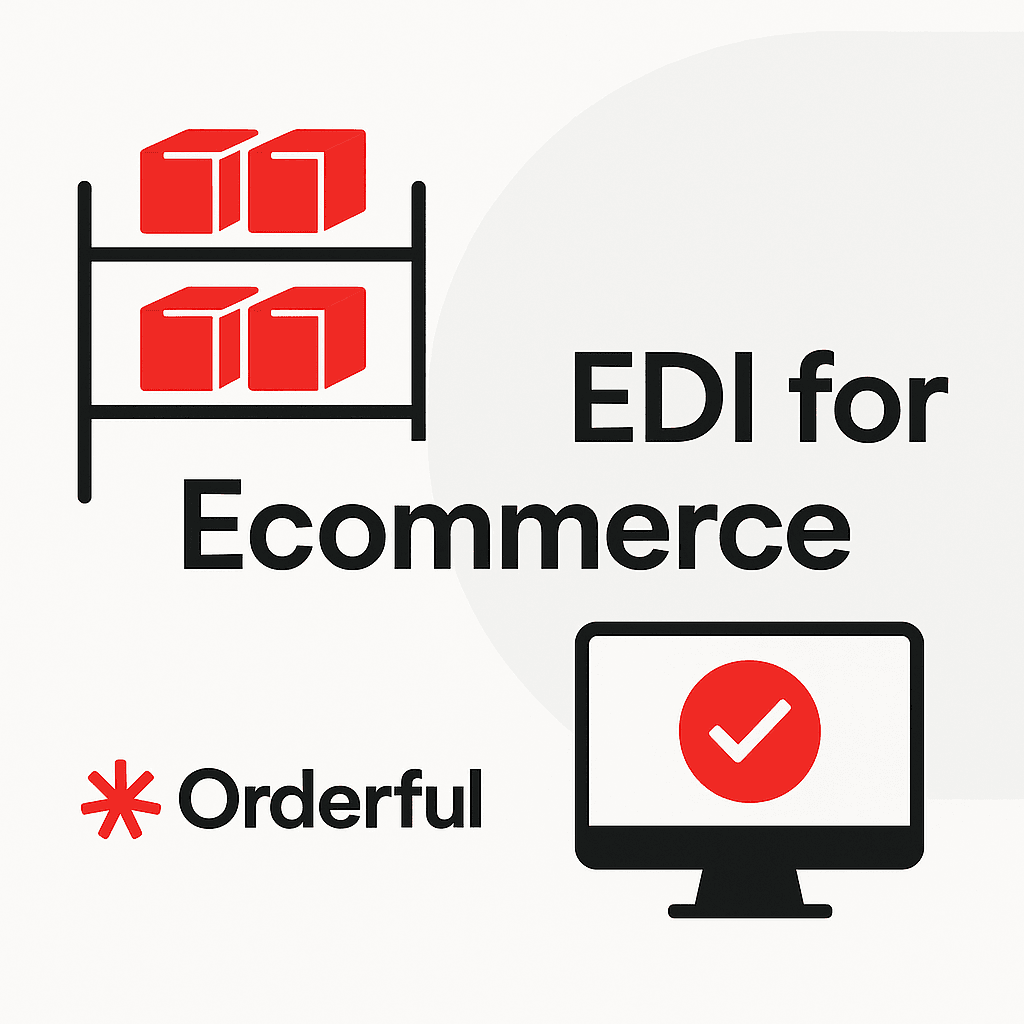Discover how modern EDI platforms support ecommerce growth through faster integrations, real-time data exchange, and simplified partner onboarding.
What Is EDI for Ecommerce?
EDI for ecommerce is the use of electronic data interchange (EDI) to automate the exchange of business documents, such as orders, invoices, and shipping notices, between ecommerce platforms and trading partners.
Why is EDI Important for Ecommerce?
EDI eliminates manual data entry and enables fast, error-free communication with retailers, suppliers, and 3PLs, improving fulfillment, inventory accuracy, and scalability.
What are Examples of EDI in Ecommerce?
Common EDI documents include purchase orders (850), invoices (810), and advance ship notices (856), all used to streamline order and delivery workflows.
Modern ecommerce moves fast, especially for brands selling through multiple channels like Shopify, Amazon, and Walmart. But as order volumes grow and partner expectations rise, managing fulfillment, inventory, and communication manually can quickly become a serious bottleneck. Electronic data interchange (EDI) for ecommerce can turn all that around, so you can meet the demands of all your ecommerce trading partners, whatever their size or reach.
EDI allows businesses to automate the exchange of business documents, like order confirmations, shipping notices, and invoices, electronically across platforms and partners. Instead of relying on manual data entry, ecommerce brands can use a single EDI system to synchronize data with retailers, suppliers, and third-party logistics providers (3PLs) in real time. This results in fewer delays, lower error rates, and a faster path to scalable growth.
Whatever your supply chain goals, automating document workflows with EDI supports cleaner operations and better customer experiences. This guide explains how ecommerce EDI works, why modern businesses are trading legacy setups for simpler, faster EDI solutions, and how EDI fits into your ecommerce fulfillment strategy as your business scales.
What Is EDI in Ecommerce and How Does it Work?
EDI in ecommerce refers to the electronic exchange of business documents between online merchants and their trading partners. EDI allows these organizations to communicate using standardized digital formats.
Most ecommerce EDI systems support formats like ANSI X12, which is widely used in North America, and EDIFACT, which is common internationally. These formats structure data in a way that both systems can interpret automatically. They follow universal EDI standards that define how information like order numbers, delivery dates, and prices should be exchanged.
By using an EDI system, ecommerce businesses can streamline how they interact with retailers like Walmart and ecommerce marketplaces like Shopify. Whether you're processing direct-to-consumer orders or fulfilling bulk retail shipments, EDI helps ensure that information flows quickly and accurately, without the lag and errors that are common with manual workflows.
What are The Benefits of EDI for Ecommerce Brands?
EDI is a strategic tool for simplifying ecommerce operations, reducing costs, and improving service across the board. By replacing manual processes with automated data exchange, EDI enables brands to scale with fewer roadblocks, delivering results such as:
Faster order processing: Automating purchase orders, invoices, and shipping notices speeds up fulfillment and reduces delays.
Improved inventory management: EDI helps prevent overselling and stockouts by providing real-time visibility into what’s on hand, what’s been ordered, and when stock levels are running low.
Fewer errors and chargebacks: Automating data entry reduces mistakes in pricing, quantities, and shipping details, which are common triggers for costly retailer chargebacks.
Better customer satisfaction: Cleaner data and faster fulfillment lead to fewer support issues, missed shipments, or inventory mismatches.
Smoother onboarding for new partners: EDI simplifies integration with new retailers, suppliers, or 3PLs, whether expanding channels or going through an ERP migration.
Because modern EDI solutions often support enterprise application integration, they can also align with your existing tech stack without major disruption.
How EDI Integration Works With Your Ecommerce Stack
A successful EDI integration connects your ecommerce platform to the rest of your business systems, such as your ERP and warehouse management system (WMS). These connections enable seamless data exchange across your entire order and fulfillment workflow.
In traditional setups, companies often rely on middleware or third-party vendors to pass EDI data between platforms. These approaches can introduce lag and complexity, leading to high support costs. Legacy systems also often struggle to adapt when order volumes increase or when trading partners require different formats.
A modern EDI service, such as API-first platforms, connects directly with ERPs and 3PLs for faster, more flexible document exchange. This improves speed and data accuracy and simplifies maintenance and onboarding as your stack evolves.
Whether you’re connecting to systems like NetSuite or QuickBooks or exploring how to implement EDI for the first time, the right integration setup ensures that your team can automate key processes without overhauling your existing tools.
Common EDI Documents in Ecommerce
Ecommerce brands use several standardized EDI document types to manage the workflow across their supply chain. Each transaction type plays a key role in keeping partners aligned, operations flowing smoothly, and helping businesses maintain accurate inventory counts in real time.
850 – Purchase Order: Sent from the buyer to the seller to initiate a purchase. This document specifies items ordered, pricing, and delivery expectations.
856 – Advance Ship Notice (ASN): Sent from the seller to notify the buyer that a shipment is on its way. It includes tracking info, packaging details, and expected arrival times.
810 – Invoice: Issued by the seller to request payment once goods have been shipped. It confirms amounts due, item quantities, and applicable taxes or discounts.
940 – Warehouse Shipping Order: Sent from a retailer or brand to a 3PL or warehouse, authorizing them to ship products to the buyer.
997 – Functional Acknowledgment: Confirms that an EDI transmission was received and processed without structural errors.
Using these electronic documents ensures consistent, automated data exchange with trading partners, reducing confusion and delays in your ecommerce workflows.
Ecommerce Platforms That Support EDI
Whether you're running a virtual storefront or managing bulk orders, most major ecommerce platforms offer some level of EDI support, either directly or through integration tools. Choosing the right connection method depends on your order volume, partner requirements, and how your existing systems are set up.
Amazon Seller Central: Offers EDI capabilities through Amazon Vendor Central for wholesale sellers. Integration is usually handled via middleware or certified service providers.
Walmart Marketplace: Requires EDI compliance for certain vendors. Retailers can connect via APIs or through Walmart’s approved EDI gateways.
Shopify: Doesn’t support native EDI, but many businesses can connect using API-based apps or third-party middleware.
BigCommerce: Supports EDI integration through partner apps and APIs, giving merchants flexibility across B2B and B2C channels.
Adobe Commerce: Offers a robust API that supports custom EDI integration and data mapping for enterprise merchants.
Each of these platforms can be connected to modern EDI software for ecommerce through direct APIs or flexible connectors that work with your existing ecommerce platform. These API integrations allow for faster onboarding and cleaner data syncs across your sales channels.
How to Choose the Right EDI Solution
An EDI solution that fits a large retailer may not work for a growing ecommerce brand. As you evaluate providers, focus on the capabilities that will support your business processes long-term, not just the bare minimum for compliance.
When looking into EDI systems, consider these key factors:
Integration model: Some providers use legacy value-added networks (VANs) or middleware, while others offer integrated EDI through modern APIs that sync with your ecommerce platform or ERP.
Time to onboard: Look for a provider that offers prebuilt connections or guided onboarding to shorten setup times and reduce friction.
Cost structure: Understand whether you’ll be charged per partner, per document, or by usage tier, and determine whether or not those costs scale efficiently.
Support and compliance: A reliable EDI provider should help you meet trading partner requirements and stay compliant as those standards evolve.
Web EDI solutions like Orderful are designed to support growing brands with fast onboarding, flexible integrations, and visibility into all your EDI transactions. The right choice will align with your goals, reduce operational strain, and support business growth over time.
Challenges With Legacy EDI
Many ecommerce brands start with older or pieced-together EDI systems because they’re fast to deploy or already in place. But as the business grows, these setups often create more problems than they solve.
Here are a few common challenges:
Manual intervention: Legacy systems often require hand-checking or rekeying data between platforms, which increases the risk of errors and slows down fulfillment.
Slow partner onboarding: Testing and certifying connections with new retailers or 3PLs can take weeks, delaying revenue and causing friction with trading partners.
Poor integration with existing business systems: Older tools may not sync well with your ERP, ecommerce platform, or order management software.
Limited visibility and control: Many legacy platforms lack real-time insights into EDI transactions, making it hard to troubleshoot or optimize.
Compliance headaches: Outdated systems may not support the latest EDI standards or partner-specific formatting rules, putting you at risk of penalties or lost orders.
Inconsistent pricing: Transaction fees and hidden costs make it difficult to budget for future growth.
If you're seeing these red flags, it might be time to rethink your setup. A modern cloud-native EDI platform can help you clear these hurdles, reduce costs, and drive your business toward real growth.
Scalable EDI for Modern Ecommerce
The flexibility of modern EDI platforms makes them ideal for the shifting demands of ecommerce, and the right system helps maintain efficient data exchange across every partner and platform.
If you’re rethinking your integration stack or looking to modernize your data exchange processes, explore what today’s cloud-native solutions can offer. With the right partner, EDI can be your edge. Talk to an EDI expert today and see how Orderful can help you streamline and scale with confidence.
Key Takeaways: EDI for Ecommerce
EDI automates document exchange with partners like Amazon, Walmart, and 3PLs
Ecommerce brands use EDI to speed up fulfillment, reduce errors, and scale efficiently
Modern platforms offer faster onboarding, API access, and real-time visibility
Choosing the right EDI provider depends on integration speed, support, and pricing
Orderful provides cloud-native, scalable EDI solutions for fast-growing ecommerce brand
Ecommerce EDI FAQs
What is EDI for ecommerce?
EDI for ecommerce is the use of electronic data interchange to automate the exchange of documents like orders, invoices, and shipping notices between online retailers and their trading partners.
Which ecommerce platforms support EDI?
Platforms like Amazon Vendor Central, Walmart Marketplace, Shopify (via API/middleware), BigCommerce, and Adobe Commerce all support EDI integration through direct connections or third-party tools.
What are common EDI formats?
The most common EDI formats are ANSI X12 and EDIFACT. ANSI X12 is primarily used in North America, while EDIFACT is more common internationally. Both formats structure business data—like purchase orders, invoices, and shipping notices—so systems can exchange it automatically. A modern EDI platform like Orderful supports these formats natively, allowing you to meet partner requirements without complex custom mapping.
Do small ecommerce businesses need EDI?
Small ecommerce businesses benefit from EDI because it helps automate orders, reduce manual errors, and streamline fulfillment across platforms like Amazon, Walmart, and Shopify. With the right platform, you can go live quickly and stay compliant—without building infrastructure or hiring a specialist team.
How do I choose an EDI provider?
Start by looking for a provider that offers speed, flexibility, and visibility. Traditional VANs or legacy providers can slow you down with ticket-based support and hidden fees. A modern provider like Orderful gives you real-time access, transparent pricing, and prebuilt connections to leading retailers, 3PLs, and ERPs. Choose a platform that scales with your business—not one that locks you into rigid workflows
- 01What Is EDI for Ecommerce?
- 02What Is EDI in Ecommerce and How Does it Work?
- 03What are The Benefits of EDI for Ecommerce Brands?
- 04How EDI Integration Works With Your Ecommerce Stack
- 05Common EDI Documents in Ecommerce
- 06Ecommerce Platforms That Support EDI
- 07How to Choose the Right EDI Solution
- 08Challenges With Legacy EDI
- 09Scalable EDI for Modern Ecommerce
- 10Key Takeaways: EDI for Ecommerce
- 11Ecommerce EDI FAQs

